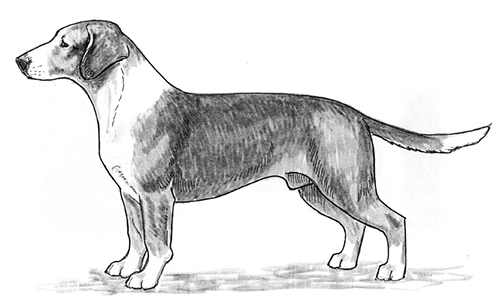Drever
Scenthound Group
The goals and purposes of this breed standard include: to furnish guidelines for breeders who wish to maintain the quality of their breed and to improve it; to advance this breed to a state of similarity throughout the world; and to act as a guide for judges.
Breeders and judges have the responsibility to avoid any conditions or exaggerations that are detrimental to the health, welfare, essence and soundness of this breed, and must take the responsibility to see that these are not perpetuated.
Any departure from the following should be considered a fault, and the seriousness with which the fault should be regarded should be in exact proportion to its degree and its effect upon the health and welfare of the dog and on the dog’s ability to perform its traditional work.
History
Small sized German hounds were imported to Sweden in 1910. These dogs gained a reputation as very good deer trackers. In 1947, the larger variety of these dogs was given the name Drever, and it was soon recognized as a Swedish breed. They are considered the first choice breed for deer tracking but are also used for hunting hare and fox.
The Drever was recognized by the United Kennel Club January 1, 1996.
General Appearance
A robust, strong, rather short legged, rectangular breed, the Drever carries itself proudly, and has well developed muscles and an agile appearance. Secondary sex characteristics are strongly defined.
Characteristics
Keen and even tempered.
Head
Rather large in proportion to the body, the head tapers in width towards the nose.
SKULL
The skull is only slightly arched. There is little stop.
MUZZLE
The muzzle is strong, and is the same length as the skull. The bridge of the nose is straight or slightly convex. The lips are tight and close fitting.
TEETH
The Drever has a complete set of evenly spaced, white teeth meeting in a scissors or level bite.
Disqualifications: Pronounced overshot or undershot.
NOSE
Black, with well developed, open nostrils.
Fault: Flesh colored nose.
EYES
Bright and full of expression, dark brown in color. The rims are tight fitting.
Fault: Light eyes.
Disqualification: Blue eyes.
EARS
Set fairly low, medium long and broad, hanging close to the cheeks without folds. They are rounded at the tips.
Neck
Powerful, and fairly long. No dewlap.
Forequarters
The shoulders are long, broad, muscular and sloping. The upper arm is proportionally long and slopes backward to set the front legs under the body.
FORELEGS
The legs are straight, with strong bone. The pasterns are slightly sloping and springy.
Serious Faults: Crooked legs. Feet turning in or out.
Body
The chest is oval in shape, well developed, and reaches below the elbow. The distance from the sternum to the ground is 40% of the total height at the withers. The prosternum is prominent. The ribs are well developed and reach far back. The withers are well defined in males. The topline is level. The loin is strong, arched and rather short. The croup is long, broad and slightly sloping. There is a slight tuck up behind the long sternum.
Serious Faults: Too low on leg. Sway back or roach back.
Hindquarters
The thighs are broad and muscular. The stifles and hocks are well angulated. The rear pasterns are short and vertical.
Feet
Firm, with well knit toes and strong pads. The feet point straight ahead.
Tail
Long, and thick at the base, the tail is preferred carried down but may be carried higher as long as it does not rise over the back.
Disqualifications: Kinked or deformed tail.
Coat
Harsh, straight and close lying. On the neck, back and buttocks, the hair is longer. There is a brush on the underside of the tail.
Color
All colors with white markings are acceptable. Colors should be well defined, and markings symmetrical.
Disqualification: Solid white or solid liver brown.
Height
Height at the withers for males is 12.5 to 15 inches. For females, it is 11.5 to 14 inches.
Gait
Even, parallel and long reaching, with the topline remaining level.
Eliminating Faults
(An Eliminating Fault is a Fault serious enough that it eliminates the dog from obtaining any awards in a conformation event.)
Height over or under the stated size in the standard.
Disqualifications
(A dog with a Disqualification must not be considered for placement in a conformation event, and must be reported to UKC.)
Unilateral or bilateral cryptorchid.
Viciousness or extreme shyness.
Albinism.
Pronounced overshot or undershot.
Blue eyes.
Kinked or deformed tail.
Solid white or solid liver brown.

Looking for a Dog?
Find a dog that will fit your family.
Note: The breeders on this list are not endorsed by UKC.
Revised July 1, 2009
©Copyright 1996, United Kennel Club
